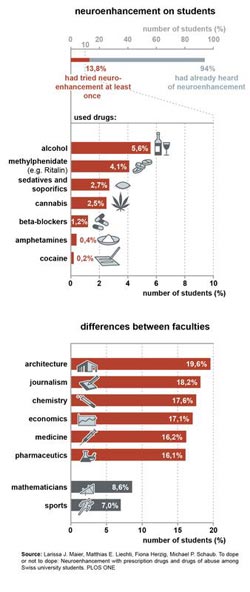One in seven students has dabbled in “smart” drugs

Besides psychostimulants like Ritalin, students also consume sedatives, alcohol or cannabis.<br>UZH<br>
These substances are mostly only taken during the exam preparation period. Only a narrow majority of polled students reported the desired effects, as a representative study conducted by researchers at the universities of Zurich and Basel reveals.
American and European studies prove that students use prescription medication or drugs to enhance their cognitive performance. Researchers from the universities of Zurich and Basel examined whether Swiss students have also experimented with neuroenhancement and which substances they take by conducting a survey of 6,725 students with an average age of 23 at the two universities and ETH Zurich.
Majority consumes soft enhancers
Around 94 percent of the students surveyed had already heard of neuroenhancement. 13.8 percent of these students had tried to improve their cognitive performance with prescription medication or legal or illegal drugs at least once during their degrees. The substance most used was alcohol (5.6%), fol-lowed by methylphenidate such as Ritalin (4.1%), sedatives and soporifics (2.7%), cannabis (2.5%), beta-blockers (1.2%), amphetamines (0.4%), and cocaine (0.2%).
The respondents primarily took these substances during the exam preparation period, only consum-ing stimulating substances rarely in the exam situation or for general stress during their degrees. While daily neuroenhancement was a rare occurrence (1.8%), the majority consumed “soft enhancers” such as caffeinated products, non-prescription vitamin products or herbal sedatives before their last big exam – around a third even every day.
The number of Swiss students who take neuroenhancing drugs is comparable with recent studies conducted at European universities. “The purported frequency of neuroenhancement at Swiss univer-sities needs to be put into perspective as we asked about psychoactive and calmative substances,” says PD Michael Schaub, the study leader and head of the Swiss Research Institute for Public Health and Addiction.
Narrow majority obtained desired effect
As a rule, advanced students who also had a job alongside their degrees and reported higher stress levels consumed performance-enhancing substances more frequently. Certain differences were ap-parent depending on the degree course: In Switzerland, students of the subjects architecture (19.6%), journalism (18.2%), chemistry (17.6%), economics (17.1%), medicine (16.2%), or pharmaceutics (16.1%) had more experience of neuroenhancement than budding mathematicians (8.6%) or sports students (7%), for instance.
According to the survey, the intended effect was only achieved in a narrow majority of the students, which is why only around half would actually take these substances to boost their brain power again. “The development of neuroenhancement at Swiss universities should be monitored as students con-stitute a high-risk group that is exposed to increased stress and performance pressure during their degrees,” concludes Schaub. “However, there is no need to intervene as yet.”
Literature:
Larissa J. Maier, Matthias E. Liechti, Fiona Herzig, Michael P. Schaub. To dope or not to dope: Neu-roenhancement with prescription drugs and drugs of abuse among Swiss university students. PLOS ONE. Doi:10.1371/journal.pone.0077967
Background
Within the scope of the study at the universities of Zurich and Basel and ETH Zurich, 28,118 stu-dents were contacted, 6,275 of whom went on to take part in the online survey. The study was con-ducted by the Swiss Research Institute for Public Health and Addiction, an associate institute of the University of Zurich, and the Division of Clinical Pharmacology at the University Hospital Basel.
Contact:
PD Dr. phil. Michael Schaub
ISGF Swiss Research Institute for Public Health and Addiction Zurich
University of Zurich
Tel. +41 44 448 11 65
E-Mail: michael.schaub@isgf.uzh.ch
Media Contact
All latest news from the category: Studies and Analyses
innovations-report maintains a wealth of in-depth studies and analyses from a variety of subject areas including business and finance, medicine and pharmacology, ecology and the environment, energy, communications and media, transportation, work, family and leisure.
Newest articles

A universal framework for spatial biology
SpatialData is a freely accessible tool to unify and integrate data from different omics technologies accounting for spatial information, which can provide holistic insights into health and disease. Biological processes…

How complex biological processes arise
A $20 million grant from the U.S. National Science Foundation (NSF) will support the establishment and operation of the National Synthesis Center for Emergence in the Molecular and Cellular Sciences (NCEMS) at…

Airborne single-photon lidar system achieves high-resolution 3D imaging
Compact, low-power system opens doors for photon-efficient drone and satellite-based environmental monitoring and mapping. Researchers have developed a compact and lightweight single-photon airborne lidar system that can acquire high-resolution 3D…





















